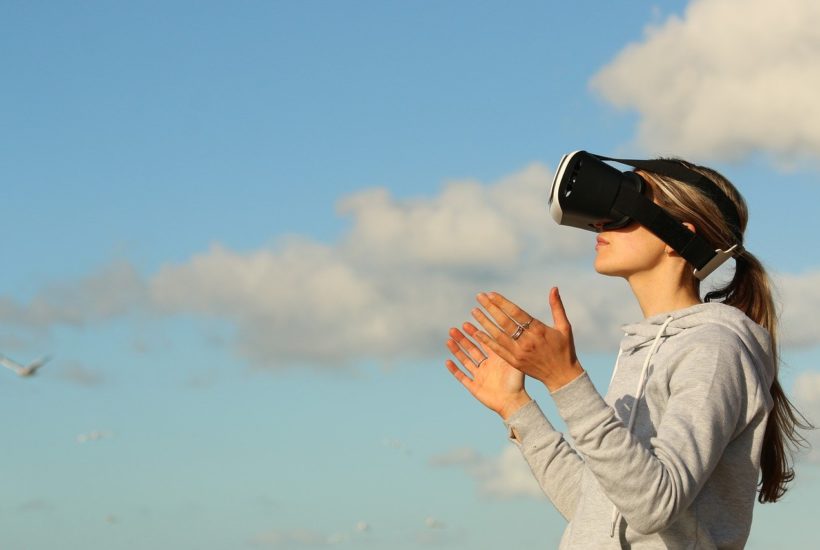Business
7 important Augmented and Virtual Reality trends for 2020
As one of the fastest-changing industries globally, AR and VR keep surprising us with fresh use cases and applications. In this article, you can read the top seven AR and VR trends in 2020. One trend that proves to be essential in customer service comes in the form of AR indoor navigation. This is a brand new use-case in virtual assistant services that seriously improves user experience in large buildings and shopping malls.

The world as we know it is not enough to satisfy the needs of picky consumers and that is why we are now witnessing the improbable rise of Augmented and Virtual Realities. It is one of the fastest-growing markets globally and it keeps surprising us with new applications and discoveries every year.
According to the report, the AR and VR industry is projected to reach $571 billion by 2025, growing at a CAGR of 63.3%. Such tremendous growth is possible thanks to the countless use cases of AR and VR, so it’s always interesting to see the latest developments in this field.
We analyzed dozens of AR and VR trends and compiled the list of the seven most important applications in 2020. Let’s check them out here!
AR in shopping
Do you know you can take advantage of AR to improve your shopping experiences? The concept is still in the initial stages of development, but lots of retailers already gain substantial benefits from this model of work.
Take IKEA Place as one of the earliest examples of AR in shopping. The app gives you an accurate impression of the furniture’s size, design, and functionality in your home. This means you can purchase the product without ever testing it to see whether it suits the dimensions of the room.
VR-powered surgery training
Surgeries represent the most difficult type of all healthcare procedures, while the time needed for practice and training is also substantial. That can change quickly thanks to the VR-powered surgery training platforms.
Instead of practicing with real patients, students and healthcare interns can now use VR equipment to perform virtual surgeries. The procedure precisely emulates every detail of the surgery, but there is no risk of hurting the patient.
For example, this video shows how the Sim-Ortho VR training simulator performs a total knee replacement procedure. VR surgery training may sound surreal, but it is a major trend in 2020.
AR indoor navigation
Another trend that proves to be essential in customer service comes in the form of AR indoor navigation. This is a brand new use-case in virtual assistant services that seriously improves user experience in large buildings and shopping malls.
Instead of wandering around with a traditional or mobile map, you can now use AR indoor navigation to get directions to the targeted store, restaurant, office, or even a single product. In other words, indoor navigation is becoming as simple as it gets these days.
AR in the automotive industry
AR goes even further to revolutionize the automotive industry as well. Namely, it has the potential to maximize manufacturing efficiency and help car owners drive more comfortably. Jake Gardner, a tech essay reviewer at the help with research paper, explains the essentials:
- AR systems display additional data about driving conditions
- AR creates the most optimal driving routes based on information like traffic jams and construction works
- AR headsets simplify training programs in car manufacturing
- This technology also reduces warehouse error rates
VR in learning
How cool it would be to learn history by visiting concrete events and people? Well, this might as well become the new norm in education because VR platforms give students the privilege of learning through experience.
For instance, Class VR is a platform that enables VR learning. It takes students to places like the Pyramids of Giza, the Maya city-state of Palenque, or any other ancient site for that matter. Such technology makes learning much more immersive and exciting than ever before, but it may take a while before it becomes mainstream.
AR in social media
We bet you’ve seen this one coming because AR is already dominating social networks. All of the biggest players like Facebook, Instagram, and TikTok rely on AR additions to improve their services. Here are only some of the most notable examples:
- Facebook uses AR-powered face recognition to simplify tagging
- Instagram is famous for its filters and other visual effects
- TikTok and Pinterest have their own lenses
These and many other features improve the social media experience and make social networking a more versatile online activity.
VR in military training
The military has always been an early adopter of new technologies, so it’s not surprising to see that it also experiments with VR. Applications of VR in military training can prepare soldiers for complex combat situations in safe virtual environments.
The purpose is to prepare soldiers for dangerous on-site situations without the risk of getting injured while training. Needless to say, such a training strategy reduces operational costs and saves the lives of many soldiers.
The bottom line
As one of the fastest-changing industries globally, AR and VR keep surprising us with fresh use cases and applications. In this post, we discussed the top seven AR and VR trends in 2020. Which one did you like the most and do you know other interesting trends in this field? Share a comment and we’ll get back to you soon!
__
(Featured image by Pexels via Pixabay)
DISCLAIMER: This article was written by a third party contributor and does not reflect the opinion of Born2Invest, its management, staff or its associates. Please review our disclaimer for more information.
This article may include forward-looking statements. These forward-looking statements generally are identified by the words “believe,” “project,” “estimate,” “become,” “plan,” “will,” and similar expressions. These forward-looking statements involve known and unknown risks as well as uncertainties, including those discussed in the following cautionary statements and elsewhere in this article and on this site. Although the Company may believe that its expectations are based on reasonable assumptions, the actual results that the Company may achieve may differ materially from any forward-looking statements, which reflect the opinions of the management of the Company only as of the date hereof. Additionally, please make sure to read these important disclosures.

-

 Markets2 days ago
Markets2 days agoStock Markets Surge Amid Global Uncertainty, But Storm Clouds Loom
-

 Cannabis2 weeks ago
Cannabis2 weeks agoAurora Cannabis Beats Expectations but Faces Short-Term Challenges
-

 Crowdfunding1 week ago
Crowdfunding1 week agoSavwa Wins Global Design Awards and Launches Water-Saving Carafe on Kickstarter
-

 Biotech2 weeks ago
Biotech2 weeks agoAsebio 2024: Driving Biotechnology as a Pillar of Spain and Europe’s Strategic Future

























